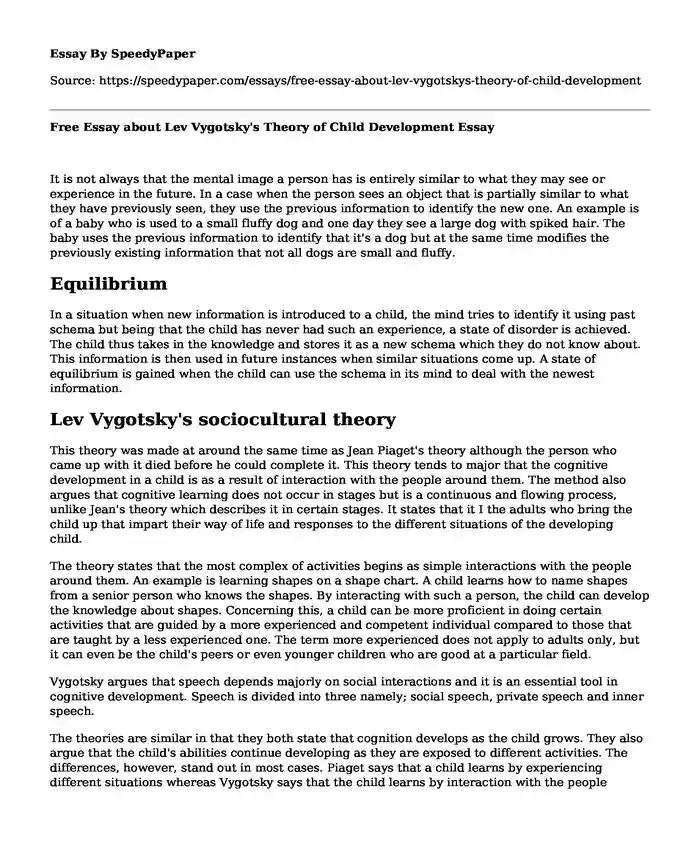
| Type of paper: | Essay |
| Categories: | Child development |
| Pages: | 3 |
| Wordcount: | 802 words |
It is not always that the mental image a person has is entirely similar to what they may see or experience in the future. In a case when the person sees an object that is partially similar to what they have previously seen, they use the previous information to identify the new one. An example is of a baby who is used to a small fluffy dog and one day they see a large dog with spiked hair. The baby uses the previous information to identify that it's a dog but at the same time modifies the previously existing information that not all dogs are small and fluffy.
Equilibrium
In a situation when new information is introduced to a child, the mind tries to identify it using past schema but being that the child has never had such an experience, a state of disorder is achieved. The child thus takes in the knowledge and stores it as a new schema which they do not know about. This information is then used in future instances when similar situations come up. A state of equilibrium is gained when the child can use the schema in its mind to deal with the newest information.
Lev Vygotsky's sociocultural theory
This theory was made at around the same time as Jean Piaget's theory although the person who came up with it died before he could complete it. This theory tends to major that the cognitive development in a child is as a result of interaction with the people around them. The method also argues that cognitive learning does not occur in stages but is a continuous and flowing process, unlike Jean's theory which describes it in certain stages. It states that it I the adults who bring the child up that impart their way of life and responses to the different situations of the developing child.
The theory states that the most complex of activities begins as simple interactions with the people around them. An example is learning shapes on a shape chart. A child learns how to name shapes from a senior person who knows the shapes. By interacting with such a person, the child can develop the knowledge about shapes. Concerning this, a child can be more proficient in doing certain activities that are guided by a more experienced and competent individual compared to those that are taught by a less experienced one. The term more experienced does not apply to adults only, but it can even be the child's peers or even younger children who are good at a particular field.
Vygotsky argues that speech depends majorly on social interactions and it is an essential tool in cognitive development. Speech is divided into three namely; social speech, private speech and inner speech.
The theories are similar in that they both state that cognition develops as the child grows. They also argue that the child's abilities continue developing as they are exposed to different activities. The differences, however, stand out in most cases. Piaget says that a child learns by experiencing different situations whereas Vygotsky says that the child learns by interaction with the people around them. Jean also thinks that children learn by self-discovery while Lev believes that children learn by tutoring from a more experienced person. Piaget argues that since the cognition is self-discovered, it does not matter where one comes from and it is similar in all people while Vygotsky states that the community imparts its way of life on a child thus making it different in different cultures. Piaget believes that speech is as a result of cognitive development, unlike Lev who thinks that it is a significant tool in the development of cognition.
Lev Vygotsky's theory proves to be more realistic compared to Piaget's. This is because different children raised from different communities differ depending on how their community sees certain aspects of life. A good example is that of a child from a traditional setting will find it hard to fit in urban life since they were not brought up in it. The theory also insists on the role of tutors who are needed to impart knowledge on the children. This is seen in everyday societies as people take their children to be taught unlike Piaget's theory that states that learning is based on previous experiences.
References
Wertsch, J. V. (Ed.). (1986). Culture, communication, and cognition: Vygotskian perspectives. CUP Archive.
Berk, L. E., & Landau, S. (1993). Private speech of learning-disabled and normally achieving children in classroom academic and laboratory contexts. Child Development, 64, 556-571.
Wadsworth, B. J. (1996). Piaget's theory of cognitive and affective development: Foundations of constructivism. Longman Publishing.
Mandler, J. M. (2014). Stories, scripts, and scenes: Aspects of schema theory. Psychology Press.
Rumelhart, D. E. (2017). Schemata: The building blocks of cognition. Theoretical issues in reading comprehension (pp. 33-58). Routledge.
Cite this page
Free Essay about Lev Vygotsky's Theory of Child Development. (2022, Jul 19). Retrieved from https://speedypaper.com/essays/free-essay-about-lev-vygotskys-theory-of-child-development
Request Removal
If you are the original author of this essay and no longer wish to have it published on the SpeedyPaper website, please click below to request its removal:
- Free Essay on Why Leaking Classified Information Is Wrong
- Management of People - HRM Essay Sample
- Is Psychology a Science? Essay Example
- Essay Example Descibing the Macular Degeneration Disease
- Free Essay on Flooding To Treat Phobia
- Novel In Country Captures Vietnam War's Impact on Young Girl
- Free Essay on Analysis of James Baldwin's Story on Notes of a Native Son
Popular categories




